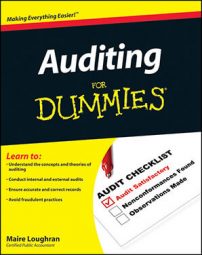Stockholders’ equity represents the claim that the corporation’s shareholders have to the company’s net assets. As an auditor you have to account for net assets. Stockholders’ equity has three common components: paid-in capital, treasury stock, and retained earnings.
Three types of business entities exist: corporations, sole proprietorships, and flow-through entities such as partnerships. Stockholders’ equity applies only to the corporate business entity. The comparable partnership account is called partners’ equity. For sole proprietorships, the account is called owners’ equity. The majority of clients you’ll be assigned as a new auditor will be corporations, the following applies to that type of business.
Paid-in capital: Paid-in capital represents money that shareholders invest in a business. There are some subcategories:
Common and preferred stock: Common and preferred stock show ownership in a corporation. What’s the difference between the two? As the names imply, preferred stock represents a higher rung on the ownership ladder than common stock. Common stock represents residual ownership, which means that owners of common stock have a claim on any remaining net assets only after preferred stockholders’ claims are paid. Because of this characteristic of common stock, preferred stock shows traits of both debt and equity.
Consider an example: Say that the shareholders of a fictional company (FPD) decide to close the business. All corporate assets are sold, and the proceeds are used to pay all remaining bills. After all the creditors are paid, the preferred stockholders get back the money they’ve invested in the company, plus any cash dividends owed to them. Any funds left over are then distributed to the common stockholders.
If it seems like common stockholders are treated like mud, take heart: Common stockholders have voting rights, which preferred stockholders usually don’t have. That means common stockholders are the ones who vote in members of the board of directors and who vote to approve changes to the corporate charter.
Additional paid-in capital: Additional paid-in capital is the excess of what shareholders pay to buy stock over the stock’s par value. Par value is what’s printed on the face of the stock certificate. Additional paid-in capital is shown on the balance sheet as a component of owner’s equity.
Treasury stock: Treasury stock must be recorded on the balance sheet as a contra stockholders’ equity account. Contra accounts carry a balance opposite to the normal balance. Because equity accounts normally have a credit balance, a contra equity account has a debit balance.
It’s not appropriate to record any sort of gain or loss on treasury stock transactions. Per generally accepted accounting principles (GAAP), this is a balance sheet transaction that affects stockholders’ equity and cash.
Retained earnings: Retained earnings show a company’s total net income or loss from the first day it’s in business to the date on the balance sheet you’re auditing.
Items other than net income or loss can affect retained earnings. Paying dividends and correcting prior period errors are two of the most common events that increase or decrease retained earnings.

